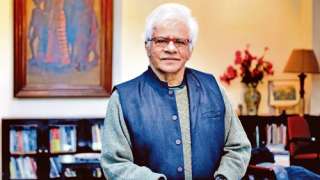MEDIA
Two encounters with memory…
www.indianculturalforum.in | April 4, 2023
This is not an obituary. I am not an art historian. But there are instances that I would like to recount and revisit and, therefore, archive for friends and posterity. A lot has been said and will be said about Vivan Sundaram’s work as an artist. How pathbreaking it was, his support for younger artists, his social commitment, and his and Geeta Kapur’s efforts at the Kasauli Art Centre, amongst many other occurrences, will be remembered as watershed events in the chronicles of contemporary art in India. All of these exist in public memory. Through this piece, I would like to recount two personal events that will hopefully enter the public domain.
Many years ago, I went to see a Vivan Sundaram installation at the CSMVS Museum in Mumbai. I will not get into the specifics of the work here. The installation involved entering a ship deck to listen to audio comprising songs and recorded voices reminiscent of a period in the city’s history, known to many but perhaps not as widely discussed as it should be. The mutiny or protest that the work referenced happened not too far from where the installation stood. It was, therefore, site-specific in some ways. Vivan Sundaram was at the venue when I arrived to see the installation. We weren’t acquainted then. He held the door open and patiently waited for us to step out. I realised he was perhaps doing this during all his time at the exhibition site. He was keen to chat with all the visitors and had specific questions: What did we see? What did we think? I saw an engaged artist at work who did not stop with the creation and exhibition of his work. His probing mind went searching and kept asking questions. Would that necessarily impact the artwork, which was now complete?
Maybe not, but I saw this as indicative of the artist’s belief in the spirit of open conversations and debate and his willingness to engage with his audience beyond flattering selfies and adulatory social media posts. I also heard from several younger artists in the city who Vivan invited to see the work. He would then take them out for lunch or dinner to listen to their thoughts about his work. This is indeed a heartwarming gesture for a senior artist to engage with the younger lot to understand what they think and seek feedback in some ways. If you think about it, it also upends hierarchy and fosters democracy of listening without the distinction of seniority or age. The senior artist is also a learner and seeker; feedback could come from any section. Isn’t this what art should ideally do? Create a culture of critical reflection?
The second encounter directly involves me. We were curating a series of online conversations with Indian visual artists for the university where I teach. I wrote to many leading artists in the country. Most declined. Vivan accepted. In fact, he was most excited that someone working in the realm of literary and cultural studies had written to him and his interlocutors would be teachers and students of the liberal arts and not restricted to art history or visual arts.
I then began working with him on the online talk. He sent detailed notes about what he would like to speak about. Then, images followed with precise details about the order of their appearance, title, year of the work etc. He did all this without any assistance. He also asked for a rehearsal. I asked questions and he gave engaging responses. All this at 78 and that too for a university talk. This entire experience left me most charmed. A senior artist, iconic for many, treated even an online talk with undergraduate students with utmost seriousness. He prepared, sent emails crosschecking details about the event while leaving me perplexed at his level of involvement and dedication to an online talk.
We made an event poster and shared it with him. I used a portly photo, perhaps a readily available image on the web. He responded curtly, saying he liked the picture but would prefer if I use a more informal one where he is wearing the summer kurta that he usually wears at home and he wouldn’t mind if I dropped his bio and just kept the photo. I didn’t think about it then, but I think about it now. Could the bio say any of this about the man behind the art? The photo, however, captures him perhaps the way he wanted to be remembered — on his terms, inviting the viewer to create a text of their own, to activate their ways of seeing while trying to decipher the man behind the work.
Prof. Kunal Ray is the faculty of English Literature at FLAME University.
(Source:- https://indianculturalforum.in/2023/04/04/two-encounters-with-memory/ )

